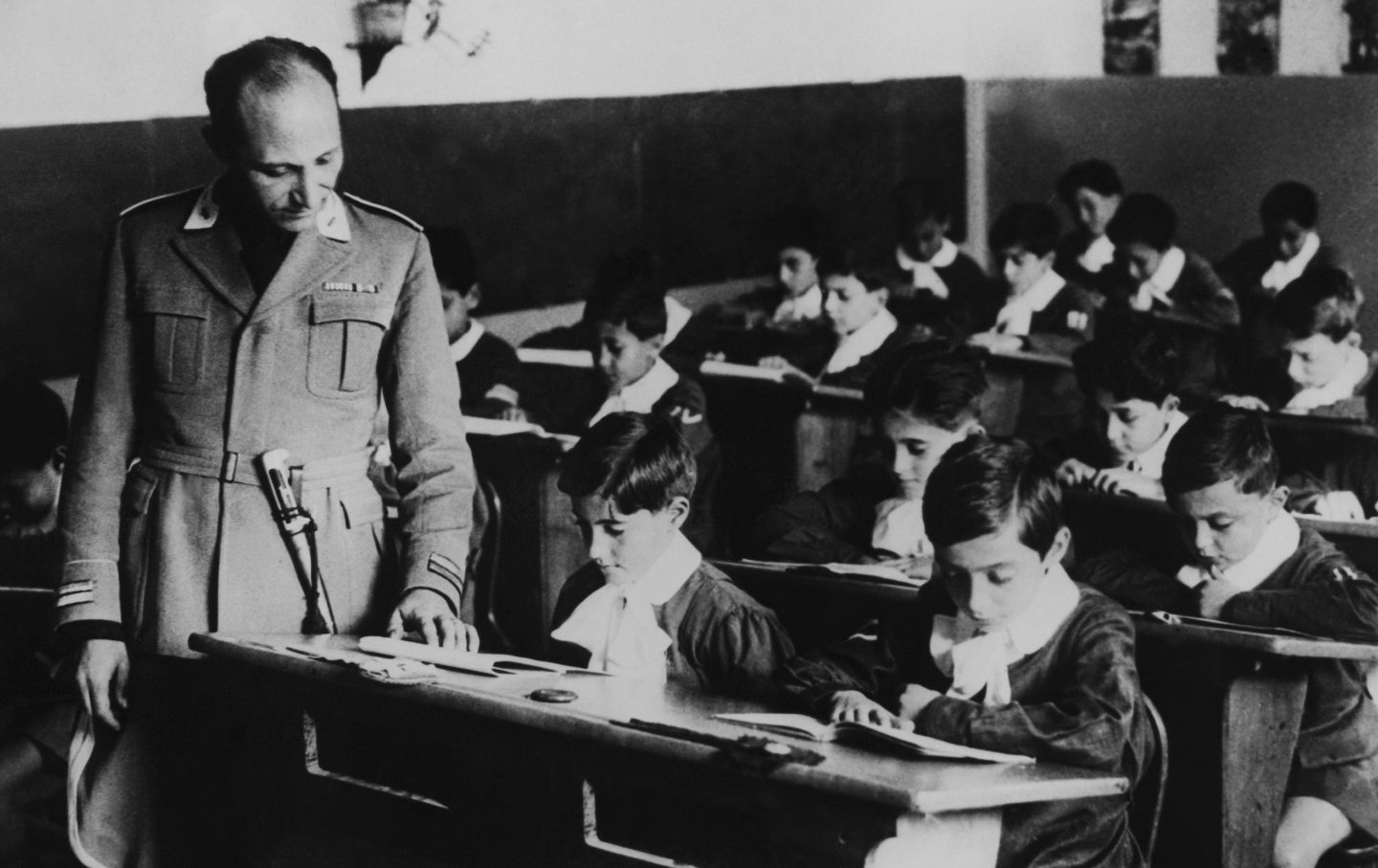The 5 Themes of Fascist Education
To fight fascism, we need to protect honest and fearless teachers.

An Italian fascist in a classroom in Italy in 1930.
(Keystone-France / Gamma-Keystone via Getty Images)
My father was 1 year old when, on May 10, 1933, the Nazis carried out a massive book burning on Opernplatz, not far from his family’s apartment. Chief among the items the Nazis burned were the contents of the vast archive of the Institut für Sexualwissenschaft (the Institute for Sexual Science), which was at the time the world’s most extensive collection of research in queer theory. According to the German American historian George L. Mosse, the institute’s Jewish director, Magnus Hirschfeld, “became a constant target of attack” after the book burning: “His own name and that of the Institute for Sexual science…which he founded in 1919, were used as metaphors for sexual perversion, symbols of the threat to bourgeois respectability posed by Weimar Berlin.”
The Nazis not only targeted Jewish intellectuals who studied queer perspectives but also sought to eliminate any suggestion that queer life was or could be normal. To do this, they would need to do more than terrorize figures like Hirschfeld—they would need to completely remake the country’s education system.
One way that the Nazis worked toward this goal was by encouraging the public to draw a connection between overly permissive educational practices and what they saw as “sexual perversion.” During the Weimar era, a small number of German educators had undertaken progressive and experimental reforms, lending students more agency in classrooms, eliminating corporal punishment, and adapting their schools to focus on “individual development, social interaction, and educating students for practical reality”—in other words, training them for participation in civic and democratic life.
These reforms were a reaction to the conservative nationalist educational model of pre–World War I Germany, which had been designed principally to support German military conquest under Kaiser Wilhem II, which was still dominant in the Weimar era.
Nevertheless, the Nazis saw even these incremental reforms as an affront and trained their propaganda machine on the country’s education system, seeking to make it even more militaristic and supportive of their nationalist aims. Their campaign of demonization linked progressive educational reforms not only to sexual perversion but also to Marxism, to draw together traditional social conservatives and wealthy business elites in a coalition against democracy and its institutions.
Educational matters were not a fleeting or insignificant area of focus within Nazi politics. The professed goal of Nazi educational policy was to defend the nation’s children from obscenity and “Marxism,” but in the Nazi imagination this task was inextricably bound up in a broader narrative of national victimhood that had lingered across much of the population ever since the 1919 Treaty of Versailles, which brought World War I to an end by confiscating about 10 percent of Germany’s territory and forcing it to pay reparations.
The aim of the Nazi education system—to transform the country’s young people into committed ideologues—was a natural extension of Germany’s pre–World War I educational model, which had focused on militarism and German supremacy. Adding Nazi educational practices and ideas to an education system with already strong antidemocratic elements produced an army of Germans willing to die for the fatherland.
What we can see from this example of Nazi Germany, and from studying other instances of fascist movements around the world, is that there are five major themes of fascist education:
- National greatness
- National purity
- National innocence
- Strict gender roles
- Vilification of the left
These themes are essentially different ways that fascist movements stoke grievances among the dominant group they serve in order to further their aims. In the process, they are careful to eliminate any contradiction of their narrative. This would include, for example, any scholarly research revealing flaws in national myths, any form of education that clearly reveals national guilt, any suggestion that diversity and plurality might be beneficial to society, or that more equitable gender relations might be beneficial, or that the political left is significantly less of a threat than they imagine.
Fascist social and political movements thrive off a sense of grievance. The Nazi education system emphasized German loss of lands in the Treaty of Versailles, blaming this loss on Jews (i.e., national innocence). According to Nazi propaganda, Jewish people were the source of the mythical “stab in the back” that had caused Germany to lose World War I. The allegation was that social-democratic politicians had betrayed the German army by entering into peace negotiations. Germany, therefore, was not to blame for the outcome of the war at all but had instead fallen victim to Jewish betrayal. Thus, all of the punishments the country had endured, particularly the loss of territory in Europe and colonies in Africa, could be traced back to the Jews. The idea that Aryan Germans should seek revenge for this betrayal was a central feature of Nazi propaganda.
The preexisting German education system that the Nazi government inherited when it took power already contained many of the elements of a fascist education—and it eagerly built upon them. The Nazi education system’s focused particularly on national greatness, taking Hitler’s words in Mein Kampf to the extreme: “Only those who through school and upbringing learn to know the cultural, economic, and above all the political, greatness of their own fatherland can and will achieve the inner pride in the privilege of being a member of such a people.”
This education system, and the propaganda apparatus it encompassed, especially the Hitler Youth, was responsible for Germany’s turn against cosmopolitanism. As the historian Gilmer W. Blackburn notes, “The Nazi success in galvanizing overwhelming national sentiment for the regime’s short-term goals appears beyond refutation. German youth, for the most part, proved receptive to simplified heroic legends and to black and white comparisons, and German teachers succumbed just as meekly to Nazi Gleichschaltung, or coordination.”
As Hitler intended it, heroic biography was meant to be the foundation in national exceptionalism, as it so often is in the United States. The exceptionalist narrative in American education has been sharpened into the very aim of education by the Trump movement. In a much-touted speech in September, during the fall 2020 presidential campaign, then-President Donald Trump introduced the White House Conference on American History with a speech about his education vision and, by extension, the education vision of his movement:
Our mission is to defend the legacy of America’s founding, the virtue of America’s heroes, and the nobility of the American character. We must clear away the twisted web of lies in our schools and classrooms, and teach our children the magnificent truth about our country.
Popular
“swipe left below to view more authors”Swipe →With an education system that emphasizes national greatness and subtly or explicitly some version of national purity, it becomes easier to lay the basis for fascism’s most powerful political trope: Great Replacement Theory, which claims that an internal enemy is trying to destroy the nation from within by importing people to “replace” the nation’s defining national group.
Great Replacement Theory has proven time and again to be a motivator for mass killing. This is true both of historical incidents of ethnic cleansing and genocide and of contemporary examples, such as the series of mass killing by people not affiliated with a state, carried out mostly during the 2010s and ’20s—in some cases by murderers who self-identify as fascist. According to this specific iteration of Great Replacement Theory, known as the White Replacement Theory, global elites seeking to diminish the power of white people have enabled the mass immigration of supposedly “high fertility” minorities.
Since 2011, this version of Great Replacement Theory has been the explicit motivation for the murder of over 160 people in such killings, including Anders Breivik’s 2011 slaughter of 77 people in Norway, Dylan Roof’s mass murder of Black churchgoers in Charleston, South Carolina, in 2015, the Tree of Life synagogue killings in 2018, the murder of 23 people, most of whom were immigrants, at a store in El Paso, Texas, in 2019, and the mass murder of ten Black people in a supermarket in Buffalo, New York, in 2022, also by a White Replacement Theory–obsessed young white man.
In Nazi ideology, it was Jewish people who were behind the plot to replace Germany’s Aryan population with non-Aryans (both the 2022 Buffalo supermarket killer and the Tree of Life synagogue killer believed Jews were behind white replacement). We have a great deal of historical evidence, both from European fascism and, more recently, from mass killings, that targeting a group of people as internal enemies responsible for replacing the nation by immigrants is dangerous. In the United States, Donald Trump has made Great Replacement Theory a theme of his presidential campaigns and his administration, blaming the plot not on Jews but on his political opponents and Democrats more generally. According to this ideology, his political opposition, the Democrats, are secret Marxists who seek to open the borders to non-white immigration, thereby displacing the white race numerically, culturally, and politically, using the results to place themselves in perpetual power. This is precisely what Hitler suspected of the Jews.
Whereas fascist education often serves to absolve the nation of its past sins, or simply erase them, the dominant narrative pushed in the United States today takes a slightly different form. According to this account, the United States did commit significant national sins—particularly its perpetuation of chattel slavery. But the seeds to overcome these sins lay in America’s founding documents, written by heroic white men—the founding fathers—whose visionary plan for the country charted a path not just to America’s absolution but also to its unique world-historical greatness. Slavery, according to this myth, was stamped out by a white man, President Abraham Lincoln, together with the heroism of what is typically presented as an entirely white Union Army. Finally, the last vestiges of racism were dispelled by the actions of a singular Black man, Martin Luther King Jr., whose radical ideas are reduced, in this narrative, to a single line from his 1963 “I Have a Dream” speech, which is misinterpreted as a plea for color-blindness.
Of course, the idea that racism has ended in the United States is patently false—but so too is the idea that the country’s founding documents provide a basis for absolution.
There is a continuum from supremacist nationalism to fascism. The German education system’s long-standing focus on German supremacy, even before the Nazi’s rise to power, smoothed the path for that country’s turn to fascism. Fascism survives off myths that create an out-group, who are relegated to, at best, second-class citizens. Schools and universities allow for critical inquiry into these myths, and so attacks on them are always the canaries in the coal mine of authoritarianism.
An education system that represents its own country as standing above all other nations in greatness and innocence makes that country susceptible to fascism. That’s why part of what is needed to stave off the collapse of the information space needed for a democracy are honest and fearless teachers. That’s why there are no American-style liberal arts colleges in authoritarian countries.
More from The Nation

Luigi Mangione Is America Whether We Like It or Not Luigi Mangione Is America Whether We Like It or Not
While very few Americans would sincerely advocate killing insurance executives, tens of millions have likely joked that they want to. There’s a clear reason why.

My Dystopian Novel Predicted Trump 2.0 My Dystopian Novel Predicted Trump 2.0
SOLIS was meant to serve as a warning of what could come. With Trump’s reelection, it should serve as a blueprint for the bravery and activism needed to fight back.

President Biden Should Issue a Blanket Pardon of Undocumented Immigrants President Biden Should Issue a Blanket Pardon of Undocumented Immigrants
Protecting Trump’s enemies from prosecution just reinforces the idea of politics as retribution. Instead, Democrats should be defending his most vulnerable targets.

The Supreme Court’s Hearing on Trans Rights Was Bigotry Masquerading as Law The Supreme Court’s Hearing on Trans Rights Was Bigotry Masquerading as Law
The conservative majority spent much of the oral arguments for US v. Skrmetti trying to erase the trans community.

Will There Be a Bird Flu Epidemic Under Trump? Will There Be a Bird Flu Epidemic Under Trump?
H5N1 currently poses a real threat for human transmission. Meanwhile, Trump’s picks for public health roles don’t bode well for vaccination.

Trans Medicine’s “Merchants of Doubt” Trans Medicine’s “Merchants of Doubt”
There is plenty of uncertainty involved in gender-affirming care—as in most aspects of medicine. But the groups behind the Tennessee ban aren’t driven by science—or patient care.


